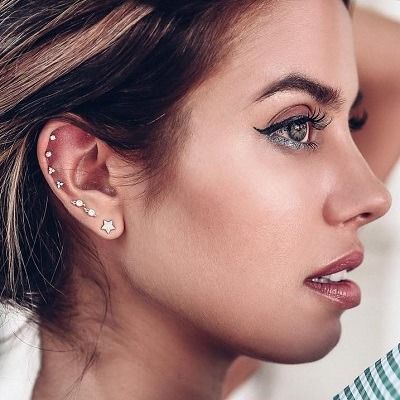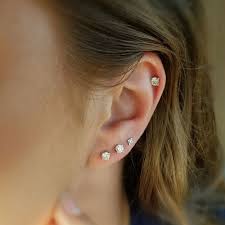Ear piercing is a common way to express personality and style. After getting a new piercing, many people experience itchiness around the pierced area. While this can be uncomfortable, it is often part of the body's natural response to the healing process. Understanding the causes of ear piercing itchiness can help manage it effectively and prevent unnecessary worry.
Normal Skin Response During Healing
Itchiness is a common sign that the skin is beginning to repair itself. After the Ear piercing Dubai the body immediately starts healing the tissue around the piercing. During this process, new skin cells are formed, and the body’s repair signals can lead to sensations like tingling or mild itching.
As long as the itching is light and not accompanied by other intense symptoms, it is usually a normal and expected part of healing. This often occurs during the early to mid stages of recovery and may come and go for a few weeks.
Dry Skin Around the Piercing
One of the most common causes of itchiness is dryness. When the skin around the piercing loses moisture, it can become tight, flaky, or rough, leading to an itchy sensation. Dryness may happen due to environmental conditions, personal habits, or friction around the area.
Exposing the pierced ear to dry air, sweat, or rubbing from accessories may worsen dryness. When the skin barrier is stressed, the body may react with mild itching as a signal that it needs extra attention or care.

Friction and Movement
Friction caused by hair, clothing, or pillows can lead to irritation around the piercing site. Even small movements of the earring during daily activities can cause the skin to become sensitive, leading to a ticklish or itchy feeling. Continuous touching or adjusting the jewelry can also disturb the skin and trigger itchiness.
Earrings that are not seated comfortably or are frequently moved may cause slight skin stress. The more movement the piercing experiences during healing, the more likely it is for the surrounding skin to become reactive and itchy.
Reaction to Materials
Some people have sensitive skin that may respond to unfamiliar materials or prolonged contact with metal. This response is often mild and shows up as itching or light redness near the piercing. It is a signal that the skin is becoming familiar with the presence of jewelry and adjusting over time.
Itchiness in these cases may fade as the skin becomes used to the jewelry. If the sensation persists or becomes more frequent, giving the area rest and avoiding further irritation can often help it settle.
Heat and Humidity
In warm or humid environments, the pierced area may feel itchy due to sweat buildup or heat exposure. Moisture can collect around the piercing and interfere with skin comfort, especially if airflow is limited. Heat and sweat trapped near the ear can make the skin feel sticky or irritated.
Wearing tight headwear or staying in hot environments for long periods may increase itchiness during this stage. Allowing the area to breathe and keeping it free from buildup can help reduce this sensation.
Healing Phase Progression
Itchiness may also occur during the natural stages of healing. As the skin renews itself, nerve endings may become more sensitive to change. This can result in temporary itchiness without any visible changes in appearance. It often means the tissue beneath the surface is recovering and regaining strength.
In some people, itching might reappear during certain phases of the healing cycle and then disappear on its own. It usually does not require interference and is best managed with a hands-off approach to let the body continue its natural work.
Physical Activity and Sweat
Engaging in physical activity can increase body temperature and lead to sweat, especially around the ears and face. Sweat buildup around the piercing can create temporary discomfort or itching. When mixed with movement, this moisture may also lead to increased friction.
Allowing the skin to cool down and gently removing excess moisture from the area after activity can help relieve itching caused by these conditions.
Emotional and Physical Stress
Sometimes, emotional stress or physical tiredness may heighten body sensitivity. The skin may respond more strongly to normal sensations like pressure or heat during stressful times, leading to increased itchiness at the site of the piercing.
Although stress is not a direct cause of irritation, it can make the body more aware of sensations that might otherwise go unnoticed. Creating a calm environment and resting when possible can support overall comfort, including around healing skin.
Daily Habits That Influence Itching
Small habits like touching the ears frequently, adjusting hair near the ears, or using rough fabrics near the head can add to itchiness. These actions may seem harmless but can repeatedly stimulate the skin, making it feel itchy or warm.
Being aware of these patterns and minimizing unnecessary contact with the ears can help the piercing remain calm. Giving the area space and avoiding repeated handling allows the skin to settle more easily.
Understanding the Body’s Signals
Itching can be the body’s way of signaling that something is changing, healing, or adjusting. While it may feel uncomfortable, it often indicates that the skin is working to return to balance. Listening to these signals without overreacting is the key to a smooth and peaceful healing experience.
Allowing the body to take its natural course and avoiding unnecessary interference helps the piercing transition into a stable and comfortable state.
Conclusion
Itchiness around a healing Ear piercing in Dubai is a common experience and often a natural sign of recovery. It can be caused by dryness, friction, sensitivity, or environmental conditions. Most of the time, it is temporary and resolves as the body adapts. By maintaining calm habits and avoiding excess interference, the skin is given the space it needs to heal smoothly. With time and patience, the itching typically fades, leaving behind a comfortable and well-set piercing.
